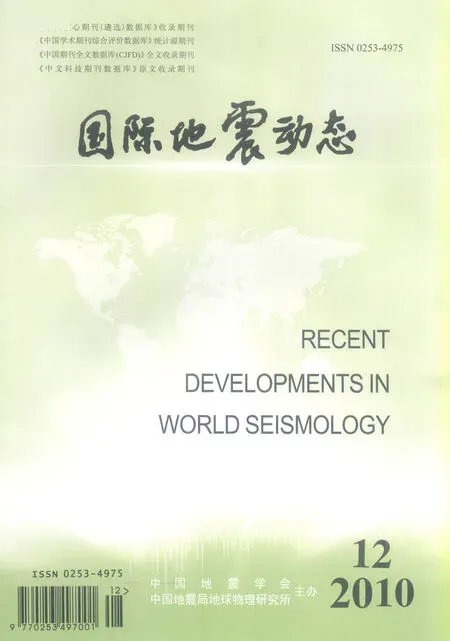美国地震学会通报(BSSA)2008年四川汶川地震专集介绍*
Klinger Y,Ji C,Shen Z-K,Bakun W H
(Institut de Physique du Globe de Paris,Centre National de la Recherche Scientifique BP89,4 place Jussieu,75005 Paris,France)
美国地震学会通报(BSSA)2008年四川汶川地震专集介绍*
Klinger Y,Ji C,Shen Z-K,Bakun W H
(Institut de Physique du Globe de Paris,Centre National de la Recherche Scientifique BP89,4 place Jussieu,75005 Paris,France)
四川汶川MW7.9地震发生在2008年5月12日北京时间14时28分(国际协调时间6时28分)。地震的突然来袭令人措手不及,因为这个位于青藏高原边缘的地区并没有被列为地震高危险区。地震造成了巨大破坏:400多万居民无家可归,伤亡人数超过8万,并有重大的经济损失。这次地震是中国近几个世纪以来最大的地震灾难之一,前两次分别是1920年海原大地震和1976年唐山大地震,它们分别夺去了20万和25万人的生命。汶川大地震发生在距2008年北京奥运会开幕只有几个月的时间,中国政府采取了空前规模的应急响应措施来应对这次地震灾害。为了不影响此次大规模救援行动的效率,在地震发生后的最初几个月,科学家很难进入地震现场。这在一定程度上妨碍了临时地震勘测网络的搭建,如GPS或国际团队的地震台站等。这种情况在任何一次大地震后往往都会出现。
与1999年MW7.7台湾集集地震、2005年MW7.6克什米尔地震一样,2008年汶川地震是世界上最大的逆冲型大陆地震之一,各种各样的地球物理台网记录了丰富的有关此次地震的实地观测资料。因此,利用这些资料认识受压状态下的应变调节过程一直以来都成为主要目标。此外,发生在龙门山脉、地处青藏高原边缘的汶川地震对科学界所持有的若干观点也提出了质疑。GPS观测结果一再显示,龙门山断裂带上几乎没有信号穿过,并且几十年来,许多科学家都坚持认为该地区只可能发生轻微的形变。汶川地震的发生显然是对这一传统观念的挑战。
尽管直接进入地震现场确实有困难,但科学家依然付出了极大的努力来研究这次地震。本期汶川地震专集的34篇论文反映了这些研究工作的部分成果。应该强调的是,这次地震对于中国地球科学界而言是一次展示活跃在中国的众多科研团队水平的特殊机会,本专集中约有60%的论文的主要作者来自中国。
本期BSSA汶川地震专集反映出对地震学感兴趣的学科非常广泛。主要有两个大的主题:强震研究(9篇)和地表破裂研究(6篇)。其余19篇论文涉及与此次地震相关的不同方面,从构造地质学到工程领域或重力场测量等。在距离汶川地震震中相当大的范围内(几公里到数百公里)有大量的强震记录(>60)数据可以使用。Bjerrum等[1]、Lu等[2]、Wang等[3]和Wen等[4]利用这些数据对地面运动预测衰减模型的不同方面进行检验。通过模拟可与实际数据相比的地面运动记录,他们测试了最近提出的下一代地面运动衰减模型,并且讨论了该模型对不同频域内数据的预测能力。Li等[5]利用距离汶川地震震中400 km范围内的强震动记录数据集,详细研究了上下盘位置效应以及破裂传播的方向效应。他们的研究表明,上下盘效应只在最初的40 km范围内和周期低于1 s时明显,而方向效应则在所有距离和频率范围内都能观测到。Ghasemi等[6]、Kurahashi和Irikura[7]通过模拟强震动记录来约束有限震源模型。这两项研究都表明,此次地震震源可被分为产生分离脉冲记录的子事件。他们还进行了另外的测试,以检验哪种有限源模型能更好地再现强震记录的频谱特性。Lu等[8]根据强震记录研究了有限源的特征。他们将汶川地震的频谱响应与其他可利用的大震记录相比较,并与中国的设计规范中的频谱相比较,结果发现在中、短周期,后者低于观测数据值,而在长周期则与观测数据值相当。Xu等[9]利用474个区域性小地震记录得出了一种绝对地面运动缩比模型,包含几何扩展方程、衰减和一个频谱衰减参数。
除了对强地面运动的大量研究外,本专集还涉及到其他方面的地震研究工作。Xu等[10]利用2000—2004年由临时地震台网记录到的中、小地震数据集计算了79个地震事件的矩张量解,结果与东喜马拉雅构造结的旋转相吻合。Smyth等[11]探讨了汶川地震后在特定时间窗口内预测强余震数量的问题。他们的研究表明,对于震级大于或等于5级的余震,基于最近的地震序列的古登堡-里克特模型(Gutenberg-Richter model)与基于修正的大森定律(Omori law)的更经典的余震预测方法在给定时间窗内预测余震数量方面同样有效。Cheng等[12]利用背景地震噪声研究了沿龙门山断裂带的速度和构造变化。他们能够清晰地探测到一个速度下降0.4%的区域,该地区正与此次地震的深部破裂区相对应。因此,他们建议该方法可用于探测孕震深度结构的时间变化。Zhang和Ge[13]将反投影方法用于澳大利亚地震台网的宽频带数据,得到了汶川地震的震源参数,包括识别出了两个主要的能量释放地块。Chaves等[14]采用新开发的地震波传播三维并行有限差分程序计算了合成低频地震图,并进一步计算了位移和最大速度分布图像。这些模拟结果很好地吻合了中国地震台网实际数据、由合成孔径雷达差分干涉测量(DInSAR)得出的汶川地震地表形变和修正后的麦加利等震线。Jiang等[15]研究了汶川地震作为一个可能的动力源而触发中国其他断层上的地震的效应。他们发现,当断层在最近的时间内(历史上)曾有活动,而且断层位于地震破裂传播的正向时,这种效应比较显著。但是,这两个条件似乎还不足以作为必然触发地震的条件。Lin[16]也研究了汶川地震的触发效应,但他的研究仅针对一个由ScS波反弹回震中地区引起的动态应力的具体实例。他的研究表明,动态应力可以达到足以触发地震的水平,并且ScS波的到时与主震15分钟后发生的MW6.0余震的时间非常吻合。
大量的文献资料都记载了与汶川地震相关的地表破裂,本专集为那些对地震地表破裂特性感兴趣的人员提供了一个宝贵的信息来源。Liu-Zeng等[17]、Ren等[18]、Yu等[19]和Zhou等[20]研究了不同的破裂部位,展示出地表破裂表现的复杂性,包括对避让带的详细研究。他们还提供了不同地区的偏移测量结果。Zhou等[20]的研究更进了一步,因为他们根据实地观测的地面破裂研究了重建的安全距离问题。Wei等[21]通过测量陡坎表面粗糙度,研究了地表破裂的另一个方面——地震陡坎形态。他们发现了粗糙度主方向存在明显差异的证据,这主要取决于地点和变形特征的变化。Liu等[22]提供了沿汶川地震破裂断层上的历史地震资料。运用14C和光释光测年技术,他们推断出该地区最近一次与汶川地震震级相当的地震发生在约2.1~1.1 ka前。Yuan等[23]的论文也与地震的地面显示有关,其内容涉及位于此次破裂北端的巨大滑坡。这种滑坡的具体形态表明垂直加速度和水平加速度都必须达到极高的水平才能触发此次地震。Densmore等[24]和Hubbard等[25]在其对龙门山断裂带运动学的讨论中,以更大的视角审视了汶川地震。Densmore等[24]强调了该地震与已知构造结构之间的联系,并指出了确定实际活动断裂带的困难性。Hubbard等[25]则基于调整楔理论,提出了一种认识龙门山断裂带的结构方案。
Furuya等[26]、Xu等[27]利用大地测量数据——包括合成孔径雷达(SAR)数据和全球定位系统(GPS)数据得出了与汶川地震破裂相关的滑移分布。这两项研究得出的最大滑移量都是10 m左右,其观测结果都显示破裂伊始是以逆冲机制为主,随着破裂向北传播,走滑机制则更为明显。
Verberne等[28]利用汶川地震现场收集的岩石样品在实验室进行摩擦试验。他们在不同温度和剪切速度下准备并测试了模拟断层泥。结果发现,该区富含粘土的沉积物可能对某一深度破裂的传播产生阻尼作用,而石灰岩则可加速传播,从而产生显著的应力降。
Lekkas[29]比较了两个烈度表EMS1998和ESI2007,完成了宏观地震研究,并给出了野外测定的烈度和地质构造之间的关系。
Deng等[30]研究了与紫坪铺水库蓄水相关的库仑应力变化。他们发现,该水库蓄水确实提高了浅层地震活动的水平,但这种应力变化太小,不足以在汶川地震震源深度产生任何显著效应。
Zhu等[31]研究了重力场变化作为大震前兆信号的可能性。他们报告说,在地震发生之前已有重力场异常的报道,并被解释为前兆信号。从这一结果出发,他们重点关注了数据的不确定性和改进数据收集的可能的方法,这将使数据集得以充实,以便进一步检验这一前兆假说。
Zhu和Zhang[32]基于龙门山断裂带的粘弹性有限元描述,提出了该断裂带的力学模型。他们对30万年的地震活动进行模拟,结果表明,发生在低角度断层面上、深度大于15 km的小地震事件往往遵从时间可预测模型,而只有当应力水平达到断层上部较陡部分的临界水平时才会发生更大的地震。
Zheng等[33]提供了一份中国地震台网中心数据管理中心有关汶川地震的最新报告。
Chen和Wang[34]就地震预测的难题提出了一种颇具意义的观点。他们讨论了中国的地震预报历史中具有里程碑意义的事件,表明到目前为止,降低地震风险最有效的方法就是按照适当的建筑规范对地震危险性作出如实的评估。
2008年汶川大地震对于中国人民来说确实是一场灾难。然而,这次地震也为中国的地球科学界提供了一次机会,他们挺身而出快速响应,树立起自己在国际学术界中的地位。本专集只介绍了他们众多研究成果的一部分,但相信该专集仍然可以为中国地球科学家与国外同行之间建立新的合作交流起到促进作用。汶川大地震是中国地震史上的标志性事件。它带来了丰富的、非常重要的地震资料,这些资料有助于加深人们对地震过程的认识,特别是对大陆挤压区地震过程的认识,同时,也有助于提高对长复发地震周期地区的地震危险性的认识。
译自:Bulletin of the Seismological Society of America,November 2010,100(5B):2353-2356,doi:10.1785/0120100172
原题:Introduction to the Special Issue on the 2008 Wenchuan,China,Earthquake
(中国地震局地球物理研究所 李平恩 译;左玉玲 校)
(译者电子信箱,李平恩:pingen2000@163.com)
[1]Bjerrum L W,Sørensen M B,Atakan K.Strong ground motion simulation of the 12 May 2008MW7.9 Wenchuan earthquake,using various slip models.Bull.Seismol.Soc.Am.,2010,100(5B):2396-2424
[2]Lu M,Li X J,An X W,et al.A comparison of recorded response spectra from the 2008 Wenchuan,China,earthquake with modern ground-motion prediction models.Bull.Seismol.Soc.Am.,2010,100(5B):2357-2380
[3]Wang D,Xie L,Abrahamson N A,et al.Comparison of strong ground motion from the Wenchuan,China,earthquake of 12 May 2008 with the Next Generation Attenuation ground-motion models.Bull.Seismol.Soc.Am.,2010,100(5B):2381-2395
[4]Wen Z,Xie J,Gao M,et al.Near-source strong ground motion characteristics of the 2008 Wenchuan earthquake.Bull.Seismol.Soc.Am.,2010,100(5B):2425-2439
[5]Li XJ,Liu L,Wang Y S,et al.Analysis of horizontal strong-motion attenuation in the great 2008 Wenchuan earthquake.Bull.Seismol.Soc.Am.,2010,100(5B):2440-2449
[6]Ghasemi H,Fukushima Y,Koketsu K,et al.Ground-motion simulation for the 2008 Wenchuan,China,earthquake using the stochastic finite-fault method.Bull.Seismol.Soc.Am.,2010,100(5B):2476-2490
[7]Kurahashi S,Irikura K.Characterized source model for simulating strong ground motions during the 2008 Wenchuan earthquake.Bull.Seismol.Soc.Am.,2010,100(5B):2450-2475
[8]Lu M,Li X J,An X W,et al.A preliminary study on the near-source strong-motion characteristics of the great 2008 Wenchuan earthquake in China.Bull.Seismol.Soc.Am.,2010,100(5B):2491-2507
[9]Xu Y,Herrmann R B,Wang C-Y,et al.Preliminary high-frequency ground-motion scaling in Yunnan and southern Sichuan,China.Bull.Seismol.Soc.Am.,2010,100(5B):2508-2517
[10]Xu Y,Herrmann R B,Koper K D.Source parameters of regional small-to-moderate earthquakes in the Yunnan-Sichuan region of China.Bull.Seismol.Soc.Am.,2010,100(5B):2518-2531
[11]Smyth C,Mori J,Jiang C.Model ensembles for prediction of Wenchuan aftershock activity.Bull.Seismol.Soc.Am.,2010,100(5B):2532-2538
[12]Cheng X,Niu F,Wang B.Coseismic velocity change in the rupture zone of the 2008MW7.9 Wenchuan earthquake observed from ambient seismic noise.Bull.Seismol.Soc.Am.,2010,100(5B):2539-2550[13]Zhang H,Ge Z.Tracking the rupture of the 2008 Wenchuan earthquake by using the relative back-projection method.Bull.Seismol.Soc.Am.,2010,100(5B):2551-2560
[14]Chavez M,Cabrera E,Madariaga R,et al.Low frequency 3D wave propagation modeling of the 12 May 2008MW7.9 Wenchuan earthquake.Bull.Seismol.Soc.Am.,2010,100(5B):2561-2573
[15]Jiang T,Peng Z,Wang W,et al.Remotely triggered seismicity in continental China following the 2008 MW7.9 Wenchuan earthquake.Bull.Seismol.Soc.Am.,2010,100(5B):2574-2589
[16]Lin C-H.A largeMW6.0 aftershock of the 2008MW7.9 Wenchuan earthquake triggered by shear waves reflected from the Earth’s core.Bull.Seismol.Soc.Am.,2010,100(5B):2858-2865
[17]Liu-Zeng J,Wen L,Sun J,et al.Surficial slip and rupture geometry on the Beichuan fault near Hongkou during theMW7.9Wenchuan earthquake,China.Bull.Seismol.Soc.Am.,2010,100(5B):2615-2650
[18]Ren J,Chen G,Xu X,et al.Surface rupture of the 2008 Wenchuan earthquake,Sichuan,China,in the Qingping step-over determined from geomorphological surveying and excavation and its tectonic implications.Bull.Seismol.Soc.Am.,2010,100(5B):2651-2659
[19]Yu G,Xu X,Klinger Y,et al.Fault-scarp features and cascading-rupture model for theMW7.9 Wenchuan earthquake,eastern Tibetan plateau,China.Bull.Seismol.Soc.Am.,2010,100(5B):2590-2614
[20]Zhou Q,Xu X,Yu G,et al.Width distribution of the surface ruptures associated with the Wenchuan earthquake:Implication for the setback zone of the seismogenic faults in post-quake reconstruction.Bull.Seismol.Soc.Am.,2010,100(5B):2660-2668
[21]Wei Z,He H,Shi F,et al.Topographic characteristics of rupture surface associated with the 12 May 2008 Wenchuan earthquake.Bull.Seismol.Soc.Am.,2010,100(5B):2669-2680
[22]Liu J F,Chen J,Yin J H,et al.OSL and AMS14C dating of the Penultimate earthquake at the Leigu trench along the Beichuan fault,Longmen Shan,in the northeast margin of the Tibetan plateau.Bull.Seismol.Soc.Am.,2010,100(5B):2681-2688
[23]Yuan R-M,Xu X-W,Chen G-H,et al.Ejection landslide at the northern terminus of Beichuan rupture triggered by the 2008MW7.9 Wenchuan earthquake.Bull.Seismol.Soc.Am.,2010,100(5B):2689-2699
[24]Densmore A L,Li Y,Richardson N J,et al.The role of late Quaternary upper-crustal faults in the 12 May 2008 Wenchuan earthquake.Bull.Seismol.Soc.Am.,2010,100(5B):2700-2712
[25]Hubbard J,Shaw J H,Klinger Y.Structural setting of the 2008MW7.9 Wenchuan,China,earthquake.Bull.Seismol.Soc.Am.,2010,100(5B):2713-2735
[26]Furuya M,Kobayashi T,Takada Y,et al.Fault source modeling of the 2008 Wenchuan earthquake based on ALOS/PALSAR data.Bull.Seismol.Soc.Am.,2010,100(5B):2750-2766
[27]Xu C,Liu Y,Wen Y,et al.Coseismic slip distribution of the 2008MW7.9 Wenchuan earthquake from joint inversion of GPS and InSAR data.Bull.Seismol.Soc.Am.,2010,100(5B):2736-2749
[28]Verberne B A,He C,Spiers CJ.Frictional properties of sedimentary rocks and natural fault gouge from the Longmen Shan fault zone,Sichuan,China.Bull.Seismol.Soc.Am.,2010,100(5B):2767-2790
[29]Lekkas E L.The 12 May 2008MW7.9 Wenchuan,China,earthquake:Macroseismic intensity assessment using the EMS-98 and ESI 2007 scales and their correlation with geological structure.Bull.Seismol.Soc.Am.,2010,100(5B):2791-2804
[30]Deng K,Zhou S,Wang R,et al.Evidence that the 2008MW7.9 Wenchuan earthquake could not have been induced by the Zipingpu Reservoir.Bull.Seismol.Soc.Am.,2010,100(5B):2805-2814
[31]Zhu Y,Zhan B F,Zhou J,et al.Gravity measurements and their variations before the 2008 Wenchuan earthquake.Bull.Seismol.Soc.Am.,2010,100(5B):2815-2824
[32]Zhu S,Zhang P.Numeric modeling of the strain accumulation and release of the 2008 Wenchuan,Sichuan,China,earthquake.Bull.Seismol.Soc.Am.,2010,100(5B):2825-2839
[33]Zheng X-F,Yao Z-X,Liang J-H,et al.The role played and opportunities provided by IGP DMC of China National Seismic Network in Wenchuan earthquake disaster relief and researches.Bull.Seismol.Soc.Am.,2010,100(5B):2866-2872
[34]Chen,Q-F,Wang K.The 2008 Wenchuan earthquake and earthquake prediction in China.Bull.Seismol.Soc.Am.,2010,100(5B):2840-2857
P315;
E;
10.3969/j.issn.0235-4975.2010.12.001
2010-12-01。
- 地震科学进展的其它文章
- 欢迎订阅2011年度《国际地震动态》

